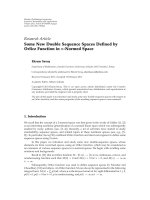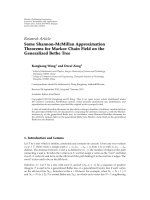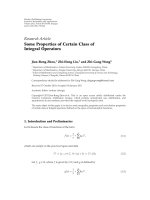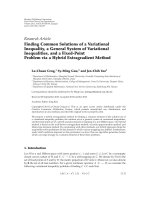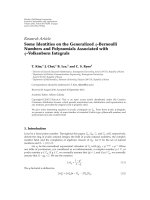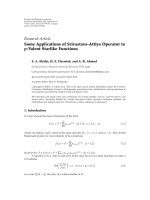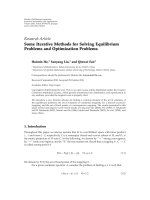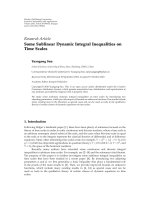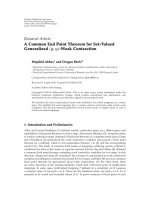Báo cáo hóa học: "Research Article Some Common Fixed Point Results in Cone Metric Spaces" docx
Bạn đang xem bản rút gọn của tài liệu. Xem và tải ngay bản đầy đủ của tài liệu tại đây (490.46 KB, 11 trang )
Hindawi Publishing Corporation
Fixed Point Theory and Applications
Volume 2009, Article ID 493965, 11 pages
doi:10.1155/2009/493965
Research Article
Some Common Fixed Point Results in Cone
Metric Spaces
Muhammad Arshad,
1
Akbar Azam,
1, 2
and Pasquale Vetro
3
1
Department of Mathematics, Faculty of Basic and Applied Sciences, International Islamic University,
H-10, 44000 Islamabad, Pakistan
2
Department of Mathematics, F.G. Postgraduate College, H-8, 44000 Islamabad, Pakistan
3
Dipartimento di Matematica ed Applicazioni, Universit
`
a degli Studi di Palermo, Via Archirafi 34,
90123 Palermo, Italy
Correspondence should be addressed to Pasquale Vetro,
Received 5 September 2008; Revised 26 December 2008; Accepted 5 February 2009
Recommended by Lech G
´
orniewicz
We prove a result on points of coincidence and common fixed points for three self-mappings
satisfying generalized contractive type conditions in cone metric spaces. We deduce some results
on common fixed points for two self-mappings satisfying contractive type conditions in cone
metric spaces. These results generalize some well-known recent results.
Copyright q 2009 Muhammad Arshad et al. This is an open access article distributed under
the Creative Commons Attribution License, which permits unrestricted use, distribution, and
reproduction in any medium, provided the original work is properly cited.
1. Introduction
Huang and Zhang 1 recently have introduced the concept of cone metric space, where
the set of real numbers is replaced by an ordered Banach space, and they have established
some fixed point theorems for contractive type mappings in a normal cone metric space.
Subsequently, some other authors 2–5 have generalized the results of Huang and Zhang 1
and have studied the existence of common fixed points of a pair of self mappings satisfying
a contractive type condition in the framework of normal cone metric spaces.
Vetro 5 extends the results of Abbas and Jungck 2 and obtains common fixed
point of two mappings satisfying a more general contractive type condition. Rezapour and
Hamlbarani 6 prove that there aren’t normal cones with normal constant c<1andfor
each k>1 there are cones with normal constant c>k. Also, omitting the assumption
of normality they obtain generalizations of some results of 1.In7 Di Bari and Vetro
obtain results on points of coincidence and common fixed points in nonnormal cone metric
spaces. In this paper, we obtain points of coincidence and common fixed points for three self-
mappings satisfying generalized contractive type conditions in a complete cone metric space.
Our results improve and generalize the results in 1, 2, 5, 6, 8.
2 Fixed Point Theory and Applications
2. Preliminaries
We recall the definition of cone metric spaces and the notion of convergence 1.LetE be a
real Banach space and P be a subset of E. The subset P is called an order cone if it has the
following properties:
i P is nonempty, closed, and P
/
{0};
ii 0 a, b ∈ R and x, y ∈ P ⇒ ax by ∈ P ;
iii P ∩ −P{0}.
For a given cone P ⊆ E, we can define a partial ordering on E with respect to P by
x y if and only if y − x ∈ P. We will write x<yif x y and x
/
y, while x y will stands
for y − x
∈ Int P, where Int P denotes the interior of P. The cone P is called normal if there is a
number κ 1 such that for all x, y ∈ E :
0 x y ⇒x κy. 2.1
The least number κ 1 satisfying 2.1 is called the normal constant of P.
In the following we always suppose that E is a real Banach space and P is an order
cone in E with Int P
/
∅ and is the partial ordering with respect to P.
Definition 2.1. Let X be a nonempty set. Suppose that the mapping d : X × X → E satisfies
i 0 dx, y, for all x, y ∈ X, and dx, y0 if and only if x y
;
ii dx, ydy, x for all x, y ∈ X;
iii dx, y dx, zdz, y, for all x, y, z ∈ X.
Then d is called a cone metric on X,andX, d is called a cone metric space.
Let {x
n
} be a sequence in X,andx ∈ X. If for every c ∈ E, with 0 c there is n
0
∈ N
such that for all n ≥ n
0
,dx
n
,x c, then {x
n
} is said to be convergent, {x
n
} converges to x
and x is the limit of {x
n
}. We denote this by lim
n
x
n
x, or x
n
→ x, as n →∞. If for every
c ∈ E with 0 c there is n
0
∈ N such that for all n, m ≥ n
0
,dx
n
,x
m
c, then {x
n
} is called a
Cauchy sequence in X. If every Cauchy sequence is convergent in X, then X is called a complete
cone metric space.
3. Main Results
First, we establish the result on points of coincidence and common fixed points for three self-
mappings and then show that this result generalizes some of recent results of fixed point.
Apairf, T of self-mappings on X is said to be weakly compatible if they commute
at their coincidence point i.e., fTx Tfx whenever fx Tx.Apointy ∈ X is called point
of coincidence of a family T
j
, j ∈ J, of self-mappings on X if there exists a point x ∈ X such
that y T
j
x for all j ∈ J.
Lemma 3.1. Let X be a nonempty set and the mappings S, T, f : X → X have a unique point
of coincidence v in X. If S, f and T,f are weakly compatibles, then S, T , and f have a unique
common fixed point.
Fixed Point Theory and Applications 3
Proof. Since v is a point of coincidence of S, T ,and f. Therefore, v fu Su Tu for some
u ∈ X. By weakly compatibility of S, f and T, f we have
Sv Sfu fSu fv, Tv Tfu fTu fv. 3.1
It implies that Sv Tv fv w say. Then w is a point of coincidence of S, T ,andf.
Therefore, v w by uniqueness. Thus v is a unique common fixed point of S, T ,andf.
Let X, d be a cone metric space, S, T, f be self-mappings on X such that SX ∪
TX ⊆ fX and x
0
∈ X. Choose a point x
1
in X such that fx
1
Sx
0
. This can be done
since SX ⊆ fX. Successively, choose a point x
2
in X such that fx
2
Tx
1
. Continuing this
process having chosen x
1
, ,x
2k
, we choose x
2k1
and x
2k2
in X such that
fx
2k1
Sx
2k,
fx
2k2
Tx
2k1
,k 0, 1, 2,
3.2
The sequence {fx
n
} is called an S-T-sequence with initial point x
0
.
Proposition 3.2. Let X, d be a cone metric space and P be an order cone. Let S, T, f : X → X be
such that SX ∪ TX ⊆ fX. Assume that the following conditions hold:
i dSx, Ty αdfx,Sxβdfy,Tyγdfx,fy, for all x, y ∈ X,withx
/
y,where
α, β, γ are nonnegative real numbers with α β γ<1;
ii dSx, Tx <dfx,Sxdfx,Tx, for all x ∈ X, whenever Sx
/
Tx.
Then every S-T-sequence with initial point x
0
∈ X is a Cauchy sequence.
Proof. Let x
0
be an arbitrary point in X and {fx
n
} be an S-T-sequence with initial point x
0
.
First, we assume that fx
n
/
fx
n1
for all n ∈ N. It implies that x
n
/
x
n1
for all n. Then,
d
fx
2k1
,fx
2k2
d
Sx
2k
,Tx
2k1
αd
fx
2k
,Sx
2k
βd
fx
2k1
,Tx
2k1
γd
fx
2k
,fx
2k1
α γd
fx
2k
,fx
2k1
βd
fx
2k1
,fx
2k2
.
3.3
It implies that
1 − βd
fx
2k1
,fx
2k2
α γd
fx
2k
,fx
2k1
, 3.4
so
d
fx
2k1
,fx
2k2
α γ
1 − β
d
fx
2k
,fx
2k1
. 3.5
4 Fixed Point Theory and Applications
Similarly, we obtain
d
fx
2k2
,fx
2k3
β γ
1 − α
d
fx
2k1
,fx
2k2
. 3.6
Now, by induction, for each k 0, 1, 2, ,we deduce
d
fx
2k1
,fx
2k2
α γ
1 − β
d
fx
2k
,fx
2k1
α γ
1 − β
β γ
1 − α
d
fx
2k−1
,fx
2k
···
α γ
1 − β
β γ
1 − α
α γ
1 − β
k
d
fx
0
,fx
1
,
d
fx
2k2
,fx
2k3
β γ
1 − α
d
fx
2k1
,fx
2k2
···
β γ
1 − α
α γ
1 − β
k1
d
fx
0
,fx
1
.
3.7
Let
λ
α γ
1 − β
, μ
β γ
1 − α
. 3.8
Then λμ < 1. Now, for p<q, we have
d
fx
2p1
,fx
2q1
d
fx
2p1
,fx
2p2
d
fx
2p2
,fx
2p3
d
fx
2p3
,fx
2p4
··· d
fx
2q
,fx
2q1
λ
q−1
ip
λμ
i
q
ip1
λμ
i
d
fx
0
,fx
1
λλμ
p
1 − λμ
λμ
p1
1 − λμ
d
fx
0
,fx
1
1 μλ
λμ
p
1 − λμ
d
fx
0
,fx
1
2λμ
p
1 − λμ
d
fx
0
,fx
1
.
3.9
Fixed Point Theory and Applications 5
In analogous way, we deduce
d
fx
2p
,fx
2q1
1 λ
λμ
p
1 − λμ
d
fx
0
,fx
1
≤
2λμ
p
1 − λμ
d
fx
0
,fx
1
,
d
fx
2p
,fx
2q
1 λ
λμ
p
1 − λμ
d
fx
0
,fx
1
≤
2λμ
p
1 − λμ
d
fx
0
,fx
1
,
d
fx
2p1
,fx
2q
1 μλ
λμ
p
1 − λμ
d
fx
0
,fx
1
≤
2λμ
p
1 − λμ
d
fx
0
,fx
1
.
3.10
Hence, for 0 <n<m
d
fx
n
,fx
m
2λμ
p
1 − λμ
, 3.11
where p is the integer part of n/2.
Fix 0 c and choose I0,δ{x ∈ E : x <δ} such that c I0,δ ⊂ Int P. Since
lim
p →∞
2λμ
p
1 − λμ
d
fx
0
,fx
1
0, 3.12
there exists n
0
∈ N be such that
2λμ
p
1 − λμ
d
fx
0
,fx
1
∈ I0,δ3.13
for all p ≥ n
0
. The choice of I0,δ assures
c −
2λμ
p
1 − λμ
d
fx
0
,fx
1
∈ Int P, 3.14
so
2λμ
p
1 − λμ
d
fx
0
,fx
1
c. 3.15
Consequently, for all n, m ∈ N,with2n
0
<n<m, we have
d
fx
n
,fx
m
c, 3.16
and hence {fx
n
} is a Cauchy sequence.
6 Fixed Point Theory and Applications
Now, we suppose that fx
m
fx
m1
for some m ∈ N.Ifx
m
x
m1
and m 2k,byii
we have
d
fx
2k1
,fx
2k2
d
Sx
2k
,Tx
2k1
<d
fx
2k
,Sx
2k
d
fx
2k1
,Tx
2k1
d
fx
2k1
,fx
2k2
,
3.17
which implies fx
2k1
fx
2k2
.Ifx
m
/
x
m1
we use i to obtain fx
2k1
fx
2k2
. Similarly, we
deduce that fx
2k2
fx
2k3
and so fx
n
fx
m
for every n ≥ m. Hence {fx
n
} is a Cauchy
sequence.
Theorem 3.3. Let X, d be a cone metric space and P be an order cone. Let S, T, f : X → X be such
that SX ∪ TX ⊆ fX. Assume that the following conditions hold:
i dSx, Ty αdfx,Sxβdfy,Tyγdfx,fy, for all x, y ∈ X,withx
/
y,where
α, β, γ are nonnegative real numbers with α β γ<1;
ii dSx, Tx <dfx,Sxdfx,Tx, for all x ∈ X, whenever Sx
/
Tx.
If fX or S
X ∪ TX is a complete subspace of X,thenS, T , and f have a unique point of
coincidence. Moreover, if S, f and T, f are weakly compatibles, then S, T , and f have a unique
common fixed point.
Proof. Let x
0
be an arbitrary point in X.ByProposition 3.2 every S-T-sequence {fx
n
} with
initial point x
0
is a Cauchy sequence. If fX is a complete subspace of X, there exist u, v ∈ X
such that fx
n
→ v fu this holds also if SX ∪ TX is complete with v ∈ SX ∪ TX.
From
dfu, Su d
fu,fx
2n
d
fx
2n
,Su
d
v, fx
2n
d
Tx
2n−1
,Su
d
v, fx
2n
αdfu,Suβd
fx
2n−1
,Tx
2n−1
γd
fu,fx
2n−1
,
3.18
we obtain
dfu,Su
1
1 − α
d
v, fx
2n
βd
fx
2n−1
,fx
2n
γd
v, fx
2n−1
. 3.19
Fix 0 c and choose n
0
∈ N be such that
d
v, fx
2n
kc, d
fx
2n−1
,fx
2n
kc, d
v, fx
2n−1
kc 3.20
for all n ≥ n
0
, where k 1−α/1βγ. Consequently dfu,Su c and hence dfu,Su
c/m for every m ∈ N.From
c
m
− dfu,Su ∈ Int P, 3.21
Fixed Point Theory and Applications 7
being P closed, as m →∞, we deduce −dfu,Su ∈ P and so dfu,Su0. This implies
that fu Su.
Similarly, by using the inequality,
dfu,Tu d
fu,fx
2n1
d
fx
2n1
,Tu
, 3.22
we can show that fu Tu. It implies that v is a point of coincidence of S, T ,andf,thatis
v fu Su Tu. 3.23
Now, we show that S, T ,andf have a unique point of coincidence. For this, assume that there
exists another point v
∗
in X such that v
∗
fu
∗
Su
∗
Tu
∗
, for some u
∗
in X. From
d
v, v
∗
d
Su, Tu
∗
αdfu,Suβd
fu
∗
,Tu
∗
γd
fu,fu
∗
αdv, vβd
v
∗
,v
∗
γd
v, v
∗
γd
v, v
∗
3.24
we deduce v v
∗
. Moreover, if S, f and T, f are weakly compatibles, then
Sv Sfu fSu fv, Tv Tfu fTu fv, 3.25
which implies Sv Tv fv w say. Then w is a point of coincidence of S, T ,andf
therefore, v w, by uniqueness. Thus v is a unique common fixed point of S, T ,andf.
From Theorem 3.3, if we choose S T, we deduce the following theorem.
Theorem 3.4. Let X, d be a cone metric space, P be an order cone and T, f : X → X be such that
TX ⊆ fX. Assume that the following condition holds:
dTx,Ty αdfx,Txβdfy,Tyγdfx,fy3.26
for all x, y ∈ X where α, β, γ ∈ 0, 1 with α β γ<1.
If fX or TX is a complete subspace of X,thenT and f have a unique point of coincidence.
Moreover, if the pair T, f is weakly compatible, then T and f have a unique common fixed point.
Theorem 3.4 generalizes Theorem 1 of 5
.
Remark 3.5. In Theorem 3.4 the condition 3.26 can be replaced by
dTx,Ty αdfx,Txdfy,Ty γdfx,fy3.27
for all x, y ∈ X, where α, γ ∈ 0, 1 with 2α γ<1.
8 Fixed Point Theory and Applications
3.27⇒3.26 is obivious. 3.26⇒3.27.Ifin3.26 interchanging the roles of x and y
and adding the resultant inequality to 3.26,weobtain
dTx,Ty
α β
2
dfx,Txdfy,Ty γdfx,fy. 3.28
From Theorem 3.4, we deduce the followings corollaries.
Corollary 3.6. Let X, d be a cone metric space, P be an order cone and the mappings T, f : X → X
satisfy
dTx,Ty γdfx,fy3.29
for all x, y ∈ X where, 0 γ<1. If TX ⊆ fX and fX is a complete subspace of X,thenT and
f have a unique point of coincidence. Moreover, if the pair T, f is weakly compatible, then T and f
have a unique common fixed point.
Corollary 3.6 generalizes Theorem 2.1 of 2, Theorem 1 of 1, and Theorem 2.3 of 6.
Corollary 3.7.
Let X, d be a cone metric space, P be an order cone and the mappings T, f : X → X
satisfy
dTx,Ty αdfx,Txdfy,Ty 3.30
for all x, y ∈ X,where0 α<1/2. If TX ⊆ fX and fX is a complete subspace of X,thenT
and f have a unique point of coincidence. Moreover, if the pair T, f is weakly compatible, then T and
f have a unique common fixed point.
Corollary 3.7 generalizes Theorem 2.3 of 2, Theorem 3 of 1, and Theorem 2.6 of 6.
Example 3.8. Let X {a, b, c}, E R
2
and P {x, y ∈ E | x, y 0}. Define d : X × X → E
as follows:
dx, y
⎧
⎪
⎪
⎪
⎪
⎪
⎪
⎪
⎪
⎪
⎨
⎪
⎪
⎪
⎪
⎪
⎪
⎪
⎪
⎪
⎩
0, 0 if x y,
5
7
, 5
if x
/
y, x, y ∈ X −{b},
1, 7 if x
/
y, x, y ∈ X −{c},
4
7
, 4
if x
/
y, x, y ∈ X −{a}.
3.31
Define mappings f, T : X → X as follow:
f xx,
Tx
⎧
⎨
⎩
c, if x
/
b,
a, if x b.
3.32
Fixed Point Theory and Applications 9
Then, if 2α γ<1
7α 4γ
7
, 7α 4γ
8α 4γ
7
, 8α 4γ
42α γ
7
, 42α γ
<
4
7
, 4
<
5
7
, 5
,
3.33
which implies
αdfb,Tbdfc,Tc γdfb,fc <dTb,Tc, 3.34
for all α, γ ∈ 0, 1 with 2α γ<1.
Therefore, Theorem 3.4 is not applicable to obtain fixed point of T or common fixed
points of f and T.
Now define a constant mapping S : X → X by Sx c, then for α 0 γ,β 5/7.
dSx, Ty
⎧
⎪
⎨
⎪
⎩
0, 0, if y
/
b,
5
7
, 5
, if y b,
αdfx,Sxβdfy,Tyγdfx,fy
5
7
, 5
if y b.
3.35
It follows that all conditions of Theorem 3.3 are satisfied for α 0 γ,β 5/7andsoS, T ,
and f have a unique point of coincidence and a unique common fixed point c.
4. Applications
In this section, we prove an existence theorem for the common solutions for two Urysohn
integral equations. Throughout this section let X Ca, b, R
n
, P {u, v ∈ R
2
: u, v ≥ 0},
and dx, yx − y
∞
,px − y
∞
for every x, y ∈ X, where p ≥ 0 is a constant. It is easily
seen that X, d is a complete cone metric space.
Theorem 4.1. Consider the Urysohn integral equations
xt
b
a
K
1
t, s, xsds gt,
xt
b
a
K
2
t, s, xsds ht,
4.1
where t ∈ a, b ⊂ R, x, g, h ∈ X. Assume that K
1
,K
2
: a, b × a, b × R
n
→ R
n
are such that
10 Fixed Point Theory and Applications
i F
x
,G
x
∈ X for each x ∈ X, where
F
x
t
b
a
K
1
t, s, xsds, G
x
t
b
a
K
2
t, s, xsds ∀t ∈ a, b, 4.2
ii there exist α, β, γ ≥ 0 such that
F
x
t − G
y
tgt − ht
,p
F
x
t − G
y
tgt − ht
≤ α
F
x
tgt − xt
,p
F
x
tgt − xt
β
G
y
tht − yt
,p
G
y
tht − yt
γ|xt − yt|,p|xt − yt|,
4.3
where α β γ<1, for every x, y ∈ X with x
/
y and t ∈ a, b.
iii whenever F
x
g
/
G
x
h
sup
t∈a,b
F
x
t − G
x
tgt − ht
,p
F
x
t − G
x
tgt − ht
< sup
t∈a,b
F
x
tgt − xt
,p
F
x
tgt − xt
sup
t∈a,b
G
x
tht − xt
,p
G
x
tht − xt
,
4.4
for every x ∈ X.
Then the system of integral equations 4.1 have a unique common solution.
Proof. Define S, T : X → X by SxF
x
g, TxG
x
h. It is easily seen that
S − T
∞
,pS − T
∞
≤ α
Sx − x
∞
,p
Sx − x
∞
β
Ty − y
∞
,p
Ty − y
∞
γ
x − y
∞
,px − y
∞
,
4.5
for every x, y ∈ X,withx
/
y and if Sx
/
Tx
S − T
∞
,pS − T
∞
<
Sx − x
∞
,p
Sx − x
∞
Tx − x
∞
,p
Tx − x
∞
4.6
for every x ∈ X.ByTheorem 3.3,iff is the identity map on X, the Urysohn integral equations
4.1 have a unique common solution.
Fixed Point Theory and Applications 11
References
1 L G. Huang and X. Zhang, “Cone metric spaces and fixed point theorems of contractive mappings,”
Journal of Mathematical Analysis and Applications, vol. 332, no. 2, pp. 1468–1476, 2007.
2 M. Abbas and G. Jungck, “Common fixed point results for noncommuting mappings without
continuity in cone metric spaces,” Journal of Mathematical Analysis and Applications, vol. 341, no. 1, pp.
416–420, 2008.
3 M. Abbas and B. E. Rhoades, “Fixed and periodic point results in cone metric spaces,” Applied
Mathematics Letters, vol. 22, no. 4, pp. 511–515, 2009.
4 D. Ili
´
candV.Rako
ˇ
cevi
´
c, “Common fixed points for maps on cone metric space,” Journal of Mathematical
Analysis and Applications, vol. 341, no. 2, pp. 876–882, 2008.
5 P. Vetro, “Common fixed points in cone metric spaces,” Rendiconti del Circolo Matematico di Palermo.
Serie II, vol. 56, no. 3, pp. 464–468, 2007.
6 S. Rezapour and R. Hamlbarani, “Some notes on the paper “Cone metric spaces and fixed point
theorems of contractive mappings”,” Journal of Mathematical Analysis and Applications, vol. 345, no. 2,
pp. 719–724, 2008.
7 C. Di Bari and P. Vetro, “ϕ-pairs and common fixed points in cone metric spaces,” Rendiconti del Circolo
Matematico di Palermo, vol. 57, no. 2, pp. 279–285, 2008.
8 P. Raja and S. M. Vaezpour, “Some extensions of Banach’s contraction principle in complete cone metric
spaces,” Fixed Point Theory and Applications, vol. 2008, Article ID 768294, 11 pages, 2008.
